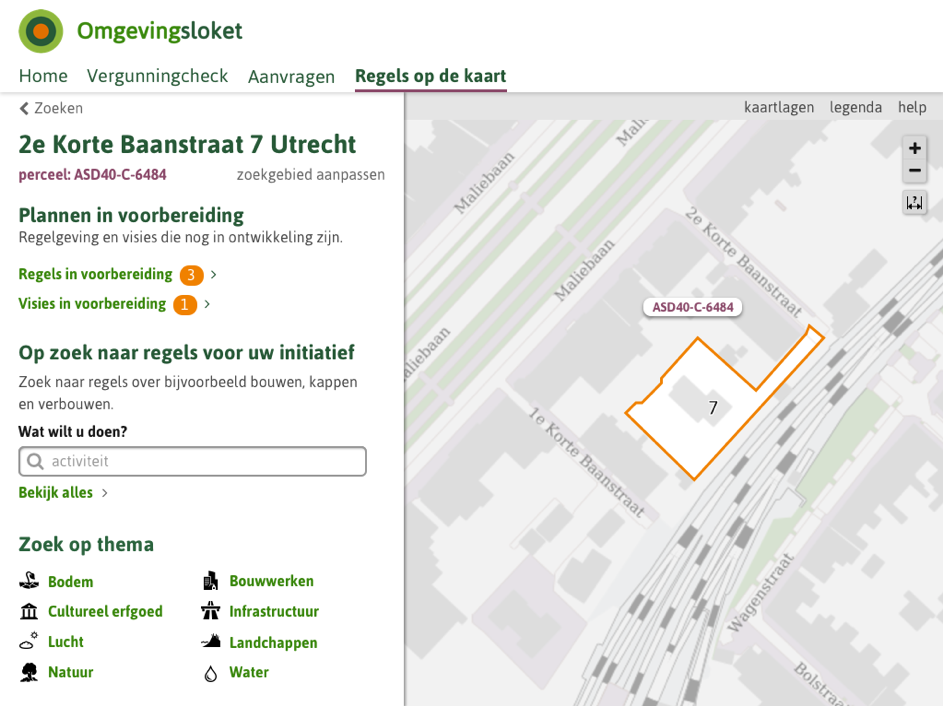In 2021, a new law will come into force: the Environment and Planning Act. The Environment and Planning Act is a law that applies to the physical environment. What exactly does this law contain, what is it for, and can or should you and your organisation do anything in response to it?
What is the Environment and Planning Act?
Our living environment is constantly changing and evolving.Many of these changes are subject to regulation.In legal terms, these changes are called activities .
This is very broad and includes everything related to nature, the environment, infrastructure and building. In short, the Environment and Planning Act lays down all of these regulations pertaining to changes to living environment.
Video: Animation on how the Environment and Planning Act combines the living environment regulations and makes them clearer. (Source: Ministry of the Interior and Kingdom Relations).
These regulations already exist. One of the starting points of the Environment and Planning Act is to make them more understandable.This will make it easier for citizens, entrepreneurs and governments to see what the possibilities are for living environment-related plans.
Up until 2021, municipal environmental regulations will be laid down in so-called zoning plans. In short, a zoning plan describes the regulations and what is allowed for one piece of land. This applies to both citizens and municipalities. For example, the zoning plan describes whether a business may be established somewhere and where roads may or may not be built. But the zoning plan also states, for example, whether a building or home may be expanded: such as through an addition or dormer. With the Environment and Planning act, the environmental plan will be an updated successor to the zoning plan.
In addition to the Municipality regulations, there are Province and Water Board regulations that must be taken into account. Through a provincial ordinance, the province can set rules on the spatial quality level such as conditions for the expansion of an agricultural building plot. For example, the water board determines what the minimum and maximum height of groundwater should be. In addition, there are State regulations, such as environmental legislation. These regulations also relate to activities in the living environment. They are important, for example, for an entrepreneur who wants to found his own car paint shop. He will have to meet certain environmental requirements in order to do so.
The Environment and Planning Act combines all of these different laws pertaining to living environment and describes the way that regulations are published. These new standards are up-to-date and therefore future-proof.
Why is the Environment and Planning Act important?
Up until 2021, all of these different regulations relating to living environment can be found in different places and plans. Quite inconvenient if you want to 'quickly' look up whether an extension is allowed at all for that house you are looking to buy. But many different laws also apply to initiatives such as building a wind farm. Right now it can take a long time to find the right regulations, or you may need to visit different help centres to get applications. With the introduction of the Environment and Planning Act, these are now things of the past.
The Environment and Planning Act will ensure that all the various regulations relating to living environment can soon be found in one central location: the Environment Desk. As a result, the processes involved in an application will be faster because the information is more transparent and easier to use.For municipalities, entrepreneurs and citizens.
A good metaphor for the Environment Desk and looking up regulations is listening to music. Not long ago, we all had a cabinet full of CDs in our living room. If we wanted to listen to a specific song, we first had to see which album we could find it on. With the advent of digital music and Spotify, we can easily play a mix of music from different artists and albums that suits our mood. We are no longer dependent on the context of the album. Instead, we choose our music more often based on mood, genre or activity.
In the 'Regulations on the map' viewer, it will soon be just as easy to view only those regulations that are relevant to a particular location and activity, without having to find out in which plan something has been published.

The Environment Act and Planning Act is an 'open system' — what does that mean?
A digital system is being built (Digital System Environment and Planning Act) to pave the way for the Environment and Planning Act.
Because there are many different parties involved in regulation, work is underway to create what is known as an 'open system'. This not only means that parties can supply information to the system, but also that they can extract information from the system in order to provide it in a way that is easy to understand.
An environmental plan must meet certain standards. Software vendors can help Municipalities meet these standards. There are still various possibilities within set standards and each software vendor will deal with this differently. The open system will allow Municipalities to choose a supplier that suits their own needs and work process
For this we can also use a Spotify comparison. We can play music through the Spotify app. But there are also several speakers available that use an alternative app and connect directly to the Spotify server. The open system allows Municipalities to choose from several suppliers for creating and offering an Environment Plan to the open system. For viewing plans as well, it will soon be possible for a software developer to build a specific application aimed at, for example, property developers or lawyers.
What does the Environment and Planning Act mean for citizens?
The Environment and Planning Act provides greater convenience for the citizen. There will be one central place to find all relevant information regarding living environment.
There will be two ways for an initiative to orient itself towards opportunities within the regulations.For frequently requested work such as installing a dormer or cutting down a tree, legal rules are converted into applicable rules.That is, the citizen does not have to read the legal texts, but is presented with a list of simple questions.After answering the questions, he or she will know whether or not a permit must be applied for.This way a resident gets immediate clarity on whether the tree in their garden can be cut down without further delay.
For a citizen who wants to know more, it becomes easier to find relevant regulations on their own. For example, a birdwatcher can look up the plans for their favourite nature reserve: will a small teashop be built there, or a large shopping mall? It is also easier to start neighbourhood initiatives, such as putting a playground on a glass-plot that is currently abandoned.
In the online Environment Desk, it will also be possible to directly apply for a permit. Thanks to improved usability, applications will be faster.
What does the Environment and Planning Act mean for municipalities and government organisations?
Municipalities and other government organisations may in the coming period start working to make their regulations easier to understand so that they can be included in the Environment and Planning Act. When we search for music to relax to in Spotify, we only get to hear music where it is indicated that that music is suitable for 'relaxing'. Each song has been given different types of labels to ensure that Spotify can group and filter them.
For example, legal regulations will also need to be annotated to make them more findable. If a user searches for information about a possible addition to their home or business, it is important that only the relevant regulations are shown in the results. Annotations ensure that these search attributes are added so that the correct regulations are found.
If citizens are better able to find the legal regulations, it does not automatically mean that they are also easy to understand. Many requested permits require that the regulations be converted to applicable regulations. This involves creating a form with questions that citizens can comprehend. After filling out the questions, the citizen gets clarity on whether a permit is required. Converting regulations into applicable regulations involves more work than annotating them. For this reason, it will not be done for all regulations. Fortunately, software already exists that can help organisations support this translation process. But Keen can also play a role in setting this up in the best possible way.
How is Keen involved in the Environment and Planning Act?
At Keen, we work on digital innovations by prioritising value for the user. Keen is a partner in the development of the Land Registry's digital user portal. There we are co-designing the "Regulations on the map" viewer, a tool that will soon make it possible to clearly see which regulations apply in which area. It's an intriguing challenge, as policymakers as well as citizens and entrepreneurs will be using this tool: different users seeking answers to their own questions.
Are you curious about what Keen Public can do for your organization? Then contact us using the button below.





